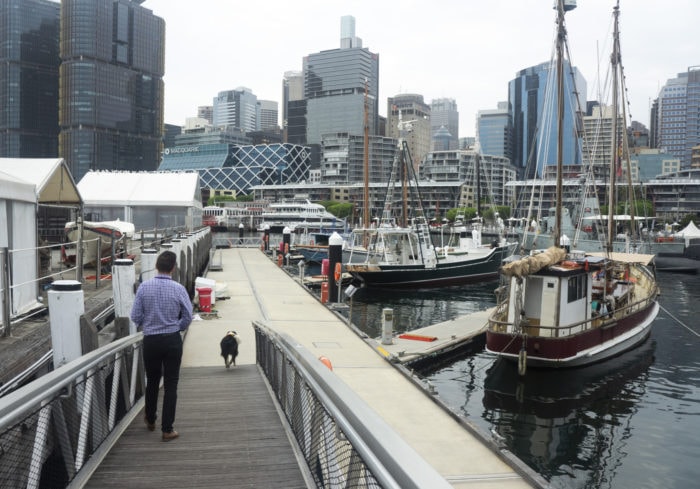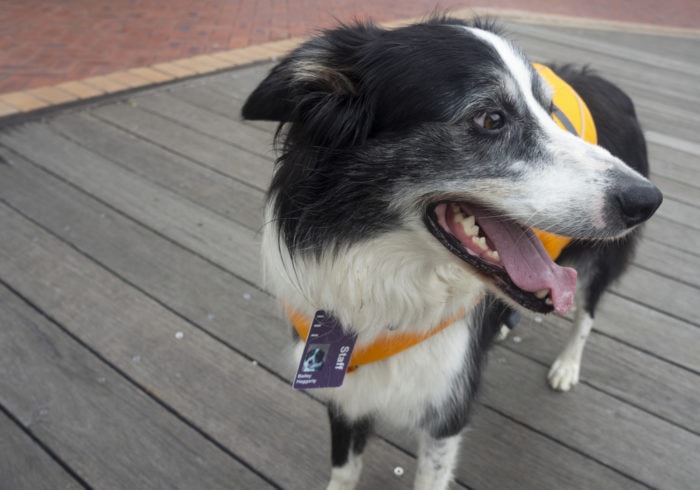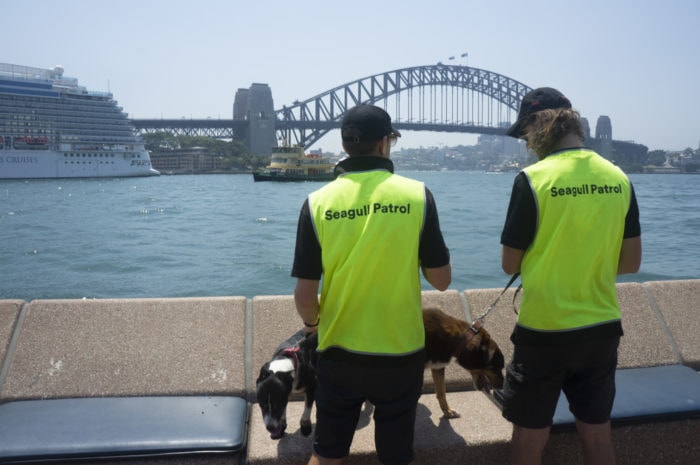Seagull patrol: meet the dogs protecting Sydney

FAKE BIRDS, sonic repellent, spray bottles: these are just a few of the measures tried and tested by the businesses that dot the fringes of Sydney to Darling Harbour, with the intention of scaring away troublesome seagulls. But all have failed.
Tasked with the job of fixing the Australian Maritime Museum’s seagull problem, head of security Adrian Snelling began searching for innovative, untested methods.
“I found that Canadian airports were using dogs to chase off seagulls from runways. I mentioned that to my manager and he said, ‘well get a dog than’, and I thought he was joking. A couple months later we had a dog,” Adrian tells Australian Geographic.
Bailey, a border collie and ex-working dog, has been with the Maritime Museum for four years now, starting at the ripe age of two. Since this time, he’s become somewhat of a Sydney icon, patrolling the wharfs and ridding the place of seagulls.

Bailey on patrol with Adrian. (Image credit: Lauren Smith/Australian Geographic)
Because the Museum has 24-hour security, it’s possible for Bailey to actually live at the Museum. “The security team were asked if they were okay with taking care of Bailey after hours, and of course they didn’t mind at all.”
Each day, Bailey wakes up for patrol in the morning with Adrian, who he spends most of his time with. Throughout the day, they’ll make walks around the Museum and Bailey will scare away any intruding birds, before settling in the late afternoon after a final patrol.
Before Bailey’s arrival, hundreds of birds would swarm the wharfs and vessels. Now, very few dare to touch their feet to the ground. “They are well aware that Bailey is around and see him as a predator. Of course, there’s still a few that take a chance, but compared to how it used to be, it’s a big difference,” says Adrian.
“We were having to wash the vessels constantly, hoping that the seagull poop wouldn’t stain and ruin the paint. He’s saved the Museum a lot of money. Not to mention, he’s very environmentally friendly as well, he saves us so much water.”

Bailey is fully equipped with a staff pass. (Image credit: Lauren Smith/Australian Geographic
Sydney Opera House’s seagull patrol
A few months ago, Adrian got a call from the management team at the Sydney Opera House who were interested in how effective Bailey had been in quelling their seagull issues. The Opera House itself, has had its fair share of seagull related dilemmas over the years.
“We’ve tried a number of solutions to manage the seagulls at our restaurants such as wire cloches for food, sonic deterrents and even a robotic hawk – but none have proved very effective,” says Jade McKellar, the director of visitor experience at the Opera House.
Adrian was asked to take Bailey down to the Opera House to see if he could be equally effective there. He was. And so the Opera House began the process of getting it’s very own Bailey.
Dog walking business owner and professional trainer James Webb and his dogs were hired by the Opera House, forming what is now known as ‘seagull patrol’, where two handlers go around the opera house– mainly the Opera House Bar– with two dogs. All up, however, James uses about five dogs with a rotating weekly roster.
“We have to give them a break and we have to keep them excited. For example, Muffin has had a few days off and now every time she spots a seagull she goes for it,” James says. Unlike Bailey, the dogs don’t live on-site but go home with James each and every night.
On a Friday afternoon, Muffin, a mixed breed dog and Tauza, a border collie, are on patrol. “They’re basically inseparable at home so they work really well together on the job, which is great because you can’t keep the seagulls at bay with just one dog,” James says.
Choosing which dogs to put on patrol was strategic, according to James. “As we were walking them, we saw which ones were chasing birds, specifically those chasing seagulls in the sky because that’s a rare behaviour,” he says. “The training takes care of itself because all we’re doing is encouraging the dogs to do what they wanna do.”

James Webb and Xavier Diekman with Muffin (left) and Tauza (right).
Working dogs rehomed
When the Maritime Museum were first on the hunt for a dog, Adrian says it was important for them that it was a rescue dog. Adrian found Bailey through Australian Working Dog Rescue (AWDR), an organisation that specialises in finding homes for Aussie working dogs, which can be difficult given the amount of energy they have.
AWDR saved Bailey from a Newcastle pound and fostered him out, until the Maritime Museum called looking for a dog that liked chasing birds. “He’s perfect for the role because he has that background being a working dog. It’s in his blood,” Adrian says.
Like Bailey, Tauza, the border collie from the Sydney Opera House has a similar story. Tauza was languishing at a farm in the Blue Mountains area. Instead of rounding sheep, he was obsessed with chickens. “His owner really loved him but she just couldn’t really let him be free because he’d just attack the chickens,” says James.
James offered to take him home to Sydney, where he’s lived with Muffin ever since. This new gig at the Opera House, James says, is a dream come true for Tauza. “He’s obsessed with birds so he loves to chase seagulls for hours. It’s nice that what was once something that was an issue, is now his purpose.”

Tauza is loving his new job at the Sydney Opera House. (Image credit: Lauren Smith/Australian Geographic)
If you enjoyed this insight, be sure to get your copy of the March/April issue of the Australian Geographic journal, which features the incredible stories of working dogs across the country. Head to your local newsagent or subscribe to the journal online. On sale 28 February 2019.




